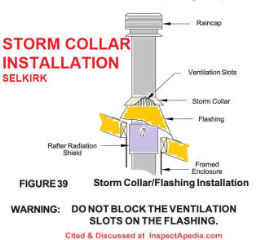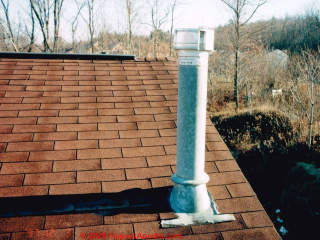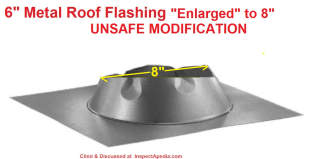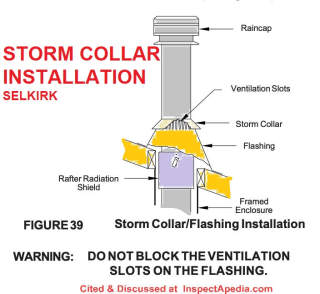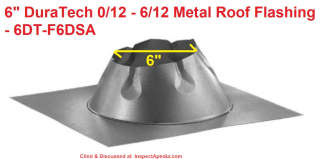 Flashing for Round Metal Chimneys & Flues
Flashing for Round Metal Chimneys & Flues
Chimney Flashing
& Storm Collar Choices & Installation
- POST a QUESTION or COMMENT about metal chimney& flue flashing choices, installation, leaks & defects
Chimney flashing installation for round metal chimneys & flues: how to choose & install round chimney flashing & storm collars.
This article series on chimneys, chimney construction, and chimney safety provides detailed suggestions describing how to perform a thorough visual inspection of chimneys for safety and other defects. Chimney inspection methods and chimney repair methods are also discussed.
InspectAPedia tolerates no conflicts of interest. We have no relationship with advertisers, products, or services discussed at this website.
- Daniel Friedman, Publisher/Editor/Author - See WHO ARE WE?
Metal Flashing & Storm Collar for Round Metal Chimneys & Flues
Installing the metal flashing and storm collar for a round metal chimney or flue that passes through a rooftop is not technically difficult, but it is important to follow the manufacturer's instructions completely: making a mistake in fire clearances, support, cooling venting, or storm collar installation can lead to a serious or even fatal chimney or building fire or may risk leaks causing costly damage to the building.
The illustration above shows a typical flashing and collar assembly for a round metal chimney or flue, adapted from Selkirk, cited just below.
In addition to preventing leaks and water entry and respecting fire clearances, your metal chimney installation will include a support kit that carries the weight of the chimney where it passes through the building roof or floors below.
Metal Chimney Flashing, Cap, Storm Collar Installation Instructions
- Hart & Cooley, CHIMNEY RAIN CAP, FLASHING, STORM COLLAR, SPARK ARRESTER INSTALLATION INSTRUCTIONS [PDF] (2013) - retrieved 2022/06/15, original source: https://www.ameri-vent.com/assets/files/15h/8513591.pdf
Excerpt: STORM COLLAR Model TLC Chimney flashings are provided with screened ventilation openings or slots at the top of the cone. In service, these openings are protected from rain by the storm collar.
DO NOT SEAL THESE OPENINGS.
Make sure the openings are not obstructed when installing the storm collar. - Selkirk, S-3 METAL CHIMNEY CAP, FLASHING, STORM COLLAR INSTALLATION INSTRUCTIONS [PDF] Selkirk, 5030 Corporate Exchange Blvd. SE, Grand Rapids, MI 49512 USA, Tel: 1-800-992-VENT (8368), - retrieved 2022/06/15, original source: https://www.selkirkcorp.com/literature/S3_Round_Top _Flashings _Storm_Collar _Spark_Arrester_and_Roof_Brace_Kit.pdf
- See also CLASS A CHIMNEYS, MetalBestos™ - installation instructions & manuals for metal chimneys
- See also additional types of metal flues & chimneys & their installation guides listed at the end of this article.
Do Not Re-use a Smaller Chimney Flashing With a New Larger Chimney
Photo: a B-vent chimney venting a gas heater in a New York home. Cutting or modifying the round flashing and collar for a B-vent or gas-vent in order to push through a larger diameter chimney of a different type for venting a different fuel such as an oil-fired heater or a wood stove is likely to be unsafe and may also violate your local building and fire codes. It also risks loss of insurance coverage should a fire or loss occur.
[Click to enlarge any image]
Several readers have asked about re-using an existing but "too-small" round metal chimney flashing when installing a new, larger metal chimney or flue.
Bottom line: don't try modifying a manufacturer's original round chimney flashing kit to fit a different size or different type of metal chimney.
The cutting and modifications to "enlarge" a "too-small" existing round metal chimney flashing risk several hazards that we list below.
Details:
There are quite a few reasons why modifying factory-designed chimney and vent products can be dangerous as well as ineffective, as we list below.
Why would someone try to modify round metal chimney flashing?
The advantage of re-use of the existing metal chimney flashing is that we avoid having to disturb the roof covering itself, as would be necessary when installing new flashing.
For an asphalt, tile, metal shingle or wood shingle/shake sloped roof, a new round metal chimney flashing installation will require loosening and probably removing some of the existing shingles or shakes to slip the upper edge and sides of the metal flashing system under the roof material.
The risks of modifying round metal chimney flashing products
If the fuel used by the new heater is different from the old one, such as changing from gas to wood fuel, the chimney design often requires more than just a larger size and use of an insulated flue.
Depending on the chimney type, additional venting is required in the chimney flashing itself - a feature not present on the gas chimney flashing system.
Watch out: cutting to enlarge around metal chimney flashing so that you can push through a larger diameter chimney will result in modified and probably reduced vent openings, risking overheating and a building fire.
Below we show what happens if you try to cut-down a standard 6-inch round metal chimney flashing kit to change to a 7-inch or 8-inch diameter opening.
Poor fit, leaks, especially if the flashing is old and corroded, possible fire clearance distance hazards with the new larger chimney, and thus having to do the job over again.
There's also the risk that when you install an unapproved, modified chimney product, not only will you lose any warranty from the chimney and woodstove manufacturers, I've seen insurance companies deny fire loss claims when they discover that an installation was completed without a permit and/or without respecting the installation instructions of the product manufacturers.
Watch out: as frequently warned in the metal storm collar chimney flashing installation instructions that we've reviewed, failure to follow the manufacturer's installation instructions could cause FIRE, CARBON MONOXIDE POISONING, or DEATH.
Also see FIRE CLEARANCES, METAL CHIMNEYS
Photo: installing an insulated metal chimney in a New York home; notice the round metal flashing at the rooftop level. The weather collar has not yet been set in place.
Reader Question: re-use round chimney flashing when switching from gas vent to woodstove?
I am changing from an existing direct-vent gas heater to a woodstove for my 1950's cottage on the Downs in Berkshire, England.
The required Class-A rated metal chimney, or insulated metal chimney for my woodstove will be two inches larger in its outside diameter than the chimney I have installed right now.
My woodstove installation contractor said he'd remove the old chimney, cut away the above-roof portion of the existing round chimney flashing, then install a new, properly sized flashing right over the old one.
I asked him why can't I just keep using the present roof flashing - I'd just trim it back to push through the new, larger metal chimney. What do you think? - Bobby Dodorino, Berkshire Downs, U.K.
Moderator reply:
Possibly you could "use" the existing on-roof flashing, though I suspect that it will be difficult to cut a perfectly-round well-sealed hole in the existing flashing working on-the roof, and I worry that there will be other unsafe conditions such as inadequate clearance from combustibles as well as the risk of having to do the job all over again when this obviously old, rusted flashing fails.
It would be helpful to see a photo description of the flashing that we are discussing.
Even with a perfect cut and meeting fire clearance from wood framing in the roof structure, you'll also need a new properly-sized collar and that will need to be sealed to the new chimney.
And as we'll discuss here, if your cutback of the metal chimney flashing reduces or changes its venting design, it may be unsafe.
Watch out: when changing fuels, such as from gas to oil or wood, not only do chimney sizes and materials change, the chimney fire clearances, and in some designs, vents built into the chimney flashing must meet different requirements.
You cannot assume that a flashing kit for a gas fueled B-vent chimney can be safely used for sealing around an oil-fuel or wood-fuel venting chimney.
Reader follow-up:
My installer would install a new larger round chimney flashing over the remains of the cut-back original one, thus avoiding disturbing the roof shingles. He says the original under-flashing, properly-integrated with the existing roof shingles will prevent any leakage.
I'm not sure that double flashing won't trap heat and so might not work right.
My present gas heater is a direct vent gas heater that combines a concentric chimney whose outer passage is a 7" OD fresh air inlet diameter.
That's just one-inch smaller than a standard 8-inch insulated chimney that will provide a six-inch ID flue for my woodstove.
Moderator reply:
I'm baffled as to how "going over the old flashing with new flashing" (presumably larger) would buy you more gain than risk and trouble.
Unless the original chimney flashing, AFTER being cut back to accept a larger chimney, still sits tall enough to avoid leaks (you don't worry as much about deep snow in Berkshire), there could still be a leak risk, and I worry that the old flashing, now out of sight, rusts and leaks into the building, causing far more-costly damage than the money you saved by re-using it.
And unless the original chimney flashing, AFTER being cut out as we're discussing also meets any heat venting requirements, it's unsafe.
You're saving only the cost of more-careful work to install the new flashing properly-integrated with the roof shingles, and you're risking the cost of much greater damage, even if safety isn't your personal worry.
So all we're doing is adding a kluge of material.
Watch out: Heat trap hazard:
Typical round metal chimney and chimney flashing and storm collar installations warn specifically that vent openings in the storm collar should not be blocked, at risk of fire.
Watch out: Venting is required & is built into flashing for some fuel type chimneys:
You need to understand as well that either your existing metal chimney flashing does not even have the required venting used with the insulated chimneys required by your woodstove, or by cutting back the flashing to pass a larger-diameter round metal chimney you're reducing or even eliminating those vent openings, creating a potentially fatal fire or CO hazard. See the illustration we include above, adapted from Selkirk whom I'll cite later.
Also, you're describing an existing "direct vent" through-roof vent system for a gas appliance - operating at substantially lower temperatures than a woodstove, and using a smaller flue.
What's the fire clearance distance from the existing chimney to nearest wood framing in the structure?
Can your new chimney meet its fire clearance requirement? Often a zero-clearance chimney still wants an inch of air space - depending on brand, model, type of chimney.
But I agree that re-working interlocking shingles on an older roof risks troublesome damage to the shingles themselves. I'd want to have the work done by someone who has experience installing and repairing metal roof shingles.
There are several roofing companies near Berkshire who offer metal roofing consulting, repairs, and installation. Have the chimney flashing installed by one of those experienced companies and you'll avoid a lot of trouble and perhaps unnecessary cost of damaged metal roof shingles.
A quick and thus incomplete search for metal roofers near Berkshire in southern England found that there's no shortage of experts:
- Bracknell Roofing Ltd.,
- Crown Roofing Contractors
- Newbury Metal Roofing
- Ramsey Roofing Limited
- Reymills Estate Metal Roof Company
- WillFix Roofing
In my OPINION, the practical concerns and risks of modifying an existing gas vent chimney to fit a wood-fueled vent chimney include at least:
Cutting back the existing flashing might permit a new larger diameter chimney to physically pass through, I agree, but at loss of flashing height, leak risks, fire clearances and other more subtle risks that you should consider:
- poor fit, leaks and water and mold damage to the building
- depending on an old flashing that looks rusted or corroded, maybe unreliable and leading to doing the same job twice
- possibly failing to provide proper fire clearance risks much greater cost than the money saved by not replacing the flashing
A new, 8-inch replacement round chimney flashing, depending on materials and features such as adjustable pitch, costs between $50 and $150. U.S.D. or 40 to 120 GBP pounds - a small price to pay for assuring a proper fit, safer installation, to which we indeed must add the greater cost of installation.
Steps to Follow if You Insist on Under-Sized Re-Using Old Round Metal Flue Chimney Flashing
Here is my OPINION of a reasonable sequence that respects your wish to re-use the old chimney if you can:
1. Comply with insurance and codes:
Establish with your insurance company that modifying and re-using an old chimney flashing and roof penetration during a change of chimney use from gas appliance to wood-burner will not affect your insurance coverage - lest you lose protection in the event of a fire or loss.
Check the same question with your local building department to be sure you're not in violation of local building codes.
2. Check that you can physically fit the new chimney
through the existing vent passage, roof opening, and cut-out rooftop flashing while meeting required fire clearance distances and new chimney manufacturer's instructions
3. Try the modification route to re-use the old roof opening & flashing:
IF steps 1 & 2 are satisfied, remove the old gas vent and try an on-roof cut-back and modification of the existing flashing to pass the new, larger insulated chimney.
At the very least, for a proper seal you'll need a new collar around the new chimney, just above the top of the old rooftop chimney flashing.
If in the course of this modification you don't see any evidence that the old flashing is rusted or corroded so as to have short remaining life then you can try it.
4. Or replace the flashing assembly with the right one.
If steps 1,2,3 don't all pass acceptably, then
work carefully to remove or loosen just enough roof shingles to remove the old flashing and then get the new flashing in place.
Consider that you may have to adjust the original chimney opening through the roof and through any ceilings below to meet required fire-clearances to combustibles. Replace the removed shingles.
The recommended articles listed at the end of this page may also be of help.
...
Continue reading at METAL CHIMNEYS & FLUES - home, or select a topic from the closely-related articles below, or see the complete ARTICLE INDEX.
Or see these
Recommended Articles
- CHIMNEY RAIN CAP / RAIN COVER INSPECTION
- FIRE CLEARANCES, METAL CHIMNEYS
- FLASHING, CHIMNEY MISTAKES & LEAKS
- FLASHING for METAL ROOFS
- METAL CHIMNEYS & FLUES - home
- METAL CHIMNEY INSTALLATION MANUALS
Suggested citation for this web page
FLASHING, CHIMNEY MISTAKES & LEAKS at InspectApedia.com - online encyclopedia of building & environmental inspection, testing, diagnosis, repair, & problem prevention advice.
Or see this
INDEX to RELATED ARTICLES: ARTICLE INDEX to CHIMNEYS & FLUES
Or use the SEARCH BOX found below to Ask a Question or Search InspectApedia
Ask a Question or Search InspectApedia
Questions & answers or comments about chimney flashing leaks & defects that are found by an on-roof inspection.
Try the search box just below, or if you prefer, post a question or comment in the Comments box below and we will respond promptly.
Search the InspectApedia website
Note: appearance of your Comment below may be delayed: if your comment contains an image, photograph, web link, or text that looks to the software as if it might be a web link, your posting will appear after it has been approved by a moderator. Apologies for the delay.
Only one image can be added per comment but you can post as many comments, and therefore images, as you like.
You will not receive a notification when a response to your question has been posted.
Please bookmark this page to make it easy for you to check back for our response.
IF above you see "Comment Form is loading comments..." then COMMENT BOX - countable.ca / bawkbox.com IS NOT WORKING.
In any case you are welcome to send an email directly to us at InspectApedia.com at editor@inspectApedia.com
We'll reply to you directly. Please help us help you by noting, in your email, the URL of the InspectApedia page where you wanted to comment.
Citations & References
In addition to any citations in the article above, a full list is available on request.
- National Fuel Gas Code, an American National Standard, 4th ed. 1988 (newer edition is available) Secretariats, American Gas Association (AGA), 1515 Wilson Blvd., Arlington VA22209, and National Fire Protection Association (NFPA), Batterymarch Park, Quincy MA 02269. ANSI Z223.1-1988 - NFPA 54-1988. WARNING: be sure to check clearances and other safety guidelines in the latest edition of these standards.
- Chimney Inspection Checklist, Carson Dunlop, Associates, Toronto, Ontario
- Our recommended books about building & mechanical systems design, inspection, problem diagnosis, and repair, and about indoor environment and IAQ testing, diagnosis, and cleanup are at the InspectAPedia Bookstore. Also see our Book Reviews - InspectAPedia.
- In addition to citations & references found in this article, see the research citations given at the end of the related articles found at our suggested
CONTINUE READING or RECOMMENDED ARTICLES.
- Carson, Dunlop & Associates Ltd., 120 Carlton Street Suite 407, Toronto ON M5A 4K2. Tel: (416) 964-9415 1-800-268-7070 Email: info@carsondunlop.com. Alan Carson is a past president of ASHI, the American Society of Home Inspectors.
Thanks to Alan Carson and Bob Dunlop, for permission for InspectAPedia to use text excerpts from The HOME REFERENCE BOOK - the Encyclopedia of Homes and to use illustrations from The ILLUSTRATED HOME .
Carson Dunlop Associates provides extensive home inspection education and report writing material. In gratitude we provide links to tsome Carson Dunlop Associates products and services.


